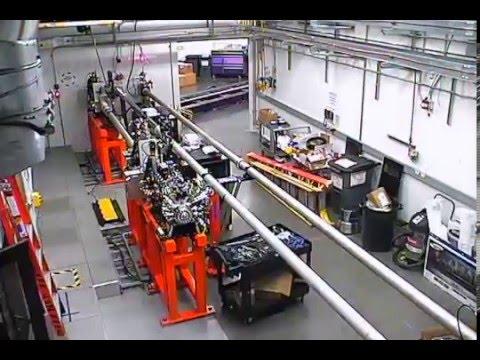New MFX Experimental Station at LCLS Sees First X-ray Light
For the first time in three years, LCLS has added a new instrument to its set of experimental stations. Staff from Stanford and SLAC gathered on Jan. 12 in the X-ray laser’s Far Experimental Hall to celebrate the arrival of the first X-rays in the brand new MFX hutch. LCLS’s seventh instrument, MFX will expand the facility’s capability and capacity by generating more opportunities for all kinds of groundbreaking user experiments.
Although MFX can support a variety of experimental settings, it was specifically designed for macromolecular femtosecond crystallography. This technique provides atomic-resolution X-ray images and ultrafast movies of biomolecules in action. It will aid researchers in unravelling crucial biological processes, from finding new ways of fighting disease to developing methods to harness solar energy similar to photosynthesis.
“MFX is going to make a big difference for the biosciences community, which has a growing demand for X-ray laser studies,” said SLAC and Stanford researcher Soichi Wakatsuki, the principal investigator for the MFX grants that initiated the project. “The instrument will increase the number of biological experiments at LCLS and will allow us to do them more efficiently.”
So far, studies of biological samples have taken place at several other LCLS instruments, including AMO and SXR, but primarily at XPP and CXI. Their versatile, multi-purpose research programs require frequent, time-consuming changes in the experimental setups and limit the time available for biostudies. MFX will help alleviate both issues.
But the addition of the new experimental station will benefit more than just bio-interested users. Since the X-ray beam can now be distributed between more instruments than before, there will be more experimental time for non-MFX users as well. The new in-hutch instrumentation, which is the focus of ongoing and future R&D, is rapidly expanding the MFX scientific capabilities in new directions.
Building the new hutch in the Far Experimental Hall took place over the past six months. Now, more equipment will be brought in to prepare for the first MFX user experiments in July.
A Collaborative Effort
“It only took a little more than two-and-a-half years from the initial idea for MFX to today’s first light,” said LCLS scientist and MFX project manager Sébastien Boutet. “None of this would have happened without the collaboration of many great people – technicians, designers, engineers, researchers and construction workers.”
LCLS ALD Mike Dunne said, “MFX is a great example of the successful collaboration between Stanford, SLAC’s Biosciences Division, SSRL and LCLS, and it may be a model for future projects that bring people together to do something remarkable.”
Similar statements were also made by others at the first-light event.
Persis Drell, dean of the Stanford School of Engineering and former SLAC director, emphasized that it was the inspiration of researchers from both SLAC and Stanford that laid the ground for the new instrument, which will make LCLS more accessible to users from around the world.
SSRL Science Director Britt Hedman pointed out that MFX is also a gateway for scientists who want to do new types of crossover experiments that make use of both X-ray light sources, LCLS and SSRL. On the SSRL side, MFX efforts are led by researcher Aina Cohen, who also oversaw the development of a broadly used experimental setup at XPP that will now be used at MFX.
“Today’s first light is a major milestone, but it’s not the end of MFX construction yet,” Wakatsuki said. “In the near future, we’ll install advanced instrumentation capable of rapid and automated use of LCLS’s X-rays, and turn MFX into a highly optimized system that will further increase the scientific productivity of the facility.”
The MFX project received financial support from the Department of Energy’s Office of Science, Biological and Environmental Research (BER) and Basic Energy Sciences (BES); the National Institute of General Medical Sciences; Stanford University and the Howard Hughes Medical Institute.

